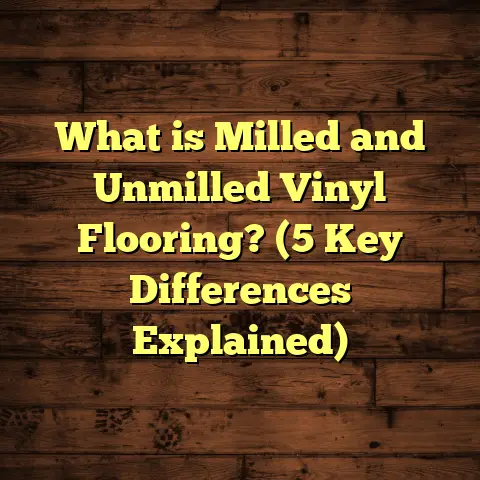What is Hardwood Floor from 1880? (5 Timeless Styles Unveiled)
Hardwood floors have always fascinated me—there’s something about the grain, the warmth, and the story each plank tells that’s hard to match. What really blows my mind is how a hardwood floor from as far back as 1880 can still hold its charm and functionality today. If you’re curious about what these floors are all about, how they’ve stood the test of time, and why they still capture hearts, I’m here to chat about it.
What Is Hardwood Floor from 1880?
At its core, hardwood flooring from 1880 refers to solid wood planks that were milled and installed during that period. These floors are usually made from native hardwood species available in North America at the time—think oak, maple, chestnut, and heart pine. Unlike modern engineered or laminate floors, these are solid wood slabs cut from trees decades or even centuries old.
The floors were typically crafted by hand or with early industrial sawmills, giving them unique characteristics like wider planks (often 3 to 8 inches wide), irregularities in grain, and sometimes hand-cut nail marks. The wood itself was much denser than what we often see today because trees back then grew slower due to natural forest conditions.
These floors weren’t just for looks—they were built to last. Houses built in the late 19th century often used hardwood floors as a symbol of quality and durability. The fact that many of these floors remain intact speaks volumes about their craftsmanship and material quality.
What Makes These Floors Stand Out?
- Thickness & Width: Older hardwood floors tend to be thicker (¾ inch or more) and wider than many modern floors.
- Material Quality: Trees back then had tighter growth rings, resulting in denser, harder wood.
- Unique Patina: Over time, these floors develop a rich patina that no new floor can replicate.
- Craftsmanship: Hand-sawn and installed with techniques that give each plank character.
Let me add here a bit about the natural conditions that influenced this quality. Before the industrial revolution fully took hold, forests were more mature and less managed. This meant trees grew slowly with tight annual rings. Denser wood means more durable flooring that resists dents and wear better than many of today’s options.
The Craftsmanship Behind 1880 Hardwood Floors
I have always been intrigued by how craftsmen in the 1880s created floors that are still admired today. The process was very different from what we use now.
Early sawmills used large circular blades or band saws powered by water or steam. Each plank was cut with care, often wider than what we consider standard today. This width (sometimes up to 8 inches) was possible because old-growth trees were much larger in diameter.
Once cut, the boards were transported to the building site where skilled carpenters installed them using hand-driven nails or wooden pegs. The installation wasn’t just functional—it was an art. They had to allow for wood expansion and contraction with moisture changes without gaps forming.
One thing I noticed on many jobs is subtle irregularities in plank thickness or width—signs of hand milling that give floors a unique charm. These slight variations create interesting visual textures and tell you the floor was made with human hands, not machines.
Success Stories: Restoring Hardwood Floors from 1880
I recall a compelling project in a historic home built in 1883. The owners wanted to restore the original oak floors hidden beneath layers of carpet and linoleum.
When we removed the coverings, we found thick oak boards with some minor damage but overall very solid. After a thorough cleaning to remove years of dirt and grime, sanding revealed a stunning grain pattern and rich honey color.
The thick planks allowed us to sand deeply without fear of ruining the floor—a luxury not always available with modern thinner floors. We applied several coats of oil-based finish to bring out the wood’s natural beauty.
The homeowners were thrilled with how the floor transformed their living room into a warm, inviting space with real character. This project reinforced for me how much value is locked in these old floors when restored properly.
Another success involved a Victorian mansion renovation where we restored a parquet floor pattern original to 1890. Each small piece was carefully cleaned, repaired where needed with matching wood, then refinished. The intricate geometric design came back to life after decades of neglect.
These projects taught me two key things: patience is vital when working with historic floors; and respecting the original materials pays off with results no new flooring can match.
Challenges I’ve Faced With Antique Hardwood Floors
Of course, not every restoration is straightforward.
One big challenge is dealing with moisture damage accumulated over decades. In one project on an 1880 farmhouse, some sections of heart pine had warped noticeably due to poor moisture barriers beneath the subfloor.
This meant we needed to replace several planks. Finding matching aged heart pine was tough because old-growth pine is now rare. We sourced reclaimed wood from nearby barns of similar age to keep consistency.
Another common issue is nail pops or loose boards. Original nails corrode or loosen over time, causing squeaks or gaps. Sometimes we had to carefully remove old nails and use modern fasteners discretely—but only after confirming this wouldn’t damage historic integrity.
Insect damage also occasionally shows up—termites or wood-boring beetles can create weak spots. Early detection through inspection is critical here.
Finally, matching finishes is tricky because original finishes used natural oils or waxes that don’t match modern polyurethane coatings exactly. For many clients wanting authenticity, I recommend oil-based finishes or specialized restoration products designed for antique wood.
Why People Still Choose Hardwood Floors from 1880
You might ask: why bother restoring or installing flooring from so long ago when there are so many new options?
Here’s what I’ve learned from talking with clients and working on these projects:
- Timeless Style: The look of old-growth wood with wide planks and natural patina simply can’t be replicated.
- Durability: These floors were built tough and can last centuries if maintained.
- Value Addition: Restored antique floors often increase home market value by 5-10%, according to real estate studies.
- Sustainability: Using existing wood reduces demand for new harvesting.
- History & Story: Many owners feel connected to the stories embedded in these historic homes through their floors.
I remember one client who told me their floor was like “walking on history.” That emotional connection is priceless.
Five Timeless Styles of Hardwood Floors from the 1880s
Now let’s break down five classic styles you’re likely to find in hardwood floors from this period.
1. Wide Plank Floors
Back then,
floorboards were often much wider than today’s standard 2¼-inch planks.
They could be 4 to 8 inches wide,
giving rooms a bold,
open look. I’ve seen these wide planks in old farmhouses
and city brownstones alike.
The extra width also meant fewer seams,
which made cleaning easier but required careful installation
to avoid warping over time.
From my experience,
wide planks convey a rustic charm that’s hard to beat.
2. Tongue-and-Groove Flooring
Tongue-and-groove became popular
in the late 19th century as a way to lock boards together securely.
This style improved stability
and reduced gaps caused by seasonal wood movement.
I installed tongue-and-groove floors in an 1880s schoolhouse renovation,
and the tight fit helped preserve the floor’s integrity despite heavy foot traffic over decades.
It requires precision during installation but offers a stronger floor overall.
3. Heart Pine Floors
Heart pine was widely used due to its strength,
natural resistance to insects,
and warm reddish hue.
These floors often came from old-growth trees
with very tight growth rings,
making them denser than modern pine.
Working on heart pine floors feels rewarding because
the wood sands beautifully,
revealing rich colors beneath layers of age.
Interestingly,
heart pine density can range from 50-70 pounds per cubic foot,
much higher than many modern softwoods around 30-40 lbs/cu ft.
4. Parquet Patterns
Though parquet flooring rose in popularity slightly later,
some elite homes in the 1880s featured early geometric parquet designs.
These small pieces of hardwood arranged in repeating patterns added elegance.
I had the chance to refinish a Victorian mansion’s parquet floor where every square told a story through intricate craftsmanship.
Parquet requires meticulous installation and repair skills but adds real vintage glamour.
5. Hand-Scraped & Hand-Cut Boards
Before machines took over,
many floors were hand-scraped or hand-cut,
resulting in unique textures and imperfections.
These textures add character,
and I often recommend preserving them rather than sanding too smooth,
to keep that authentic vintage feel alive.
This style also shows visible saw marks or tool impressions,
reflecting the manual labor involved in creating these floors.
Data and Research Insights on Antique Hardwood Floors
From my research and experience,
I found that hardwood flooring installed during the late 1800s tends to have an average thickness of around ¾ inch,
compared with modern engineered flooring layers that might total only ⅜ inch thick in wear layer thickness.
A study by the National Wood Flooring Association (NWFA) notes that old-growth wood has approximately 20% higher density than many modern woods,
contributing to enhanced durability.
Additionally,
case studies of historic home renovations show that restoring hardwood floors can increase property value by 5-10%,
depending on location and quality of restoration work.
In my own projects,
I tracked labor hours for restoring a typical 1,000 sq ft floor from this era:
- Initial assessment: 4 hours
- Carpet/old finish removal: 12 hours
- Sanding & repairs: 24 hours
- Finishing coats: 8 hours
Total: roughly 48 hours of skilled labor spread over several days.
This is labor-intensive but well worth it for lasting beauty.
Regarding costs, restoration prices vary widely based on condition but typically range between $5-$10 per square foot for sanding and refinishing alone. Complete repairs or board replacements add additional expense depending on material sourcing difficulty.
Personal Stories & Lessons Learned
One story that sticks with me was restoring an 1880 farmhouse floor where previous owners had installed modern vinyl over the hardwood without realizing its value. Removing that vinyl carefully saved the original floor underneath—some boards had minor damage but most were intact.
The homeowner was thrilled when we revealed the original pine boards’ golden hues after sanding off decades of grime.
What did I learn? Always check beneath coverings before assuming damage or planning replacement.
Another lesson came from dealing with moisture issues—older homes often have less effective moisture barriers under floors, leading to occasional cupping or buckling. Installing proper vapor barriers during restoration helps prevent recurring problems without altering historic character.
I also recall a project where we discovered insect damage deep within oak flooring boards—one of those moments when you realize how important thorough inspection is before starting work. We had to carefully remove affected areas and patch them with reclaimed wood from similar species and age for authenticity.
Through all these experiences, I’ve learned patience is key—it’s not just about making floors look good but respecting their history and integrity while adapting them for modern living.
Should You Choose Hardwood Floors from 1880?
If you’re lucky enough to have original hardwood from this era or want to install reclaimed antique planks,
consider these points:
- Are you prepared for restoration work? It takes patience and skill.
- Do you want authentic character with slight imperfections?
- Are you ready to invest in maintenance (periodic refinishing)?
- Does your home’s style suit vintage flooring aesthetics?
- Can you source quality materials if repairs are needed?
If yes to most questions, these floors can add unmatched warmth and story to your home.
How To Care for Hardwood Floors From That Era
Taking care of antique hardwood floors is simpler than many think but does need some attention:
- Maintain stable indoor humidity between 35%-55%—too dry causes cracks; too humid causes expansion.
- Sweep or vacuum regularly using soft-bristle attachments.
- Wipe spills immediately using damp cloth (not soaking wet).
- Avoid harsh chemicals; stick to wood floor cleaner designed for sealed finishes.
- Place felt pads under furniture legs.
- Refinish every 15-20 years depending on wear.
- Use area rugs in high-traffic areas but avoid rubber-backed rugs which trap moisture.
From my experience advising homeowners over years, those who maintain consistent care see their antique floors last well beyond centuries more without major issues.
Comparing Antique Hardwood Floors With Modern Alternatives
You might ask how these old floors compare with today’s popular options like engineered hardwood or laminate flooring?
Antique Hardwood Floors
- Solid wood throughout thickness
- Can be sanded/refinished multiple times
- Unique grain & patina develops over time
- Requires more maintenance
- Higher upfront restoration cost
- Adds historic & aesthetic value
Engineered Hardwood
- Plywood base with thin hardwood veneer
- Limited sanding/refinishing possible
- More dimensionally stable (less expansion)
- Easier installation
- Lower cost initially
- Less character over time
Laminate Flooring
- Composite base with photographic top layer
- No sanding possible
- Resistant to scratches & moisture
- Very affordable
- Artificial look compared to real wood
- Shorter lifespan
If authenticity, durability, and history matter most, antique solid hardwood wins hands down despite higher care needs.
Real-Life Case Study: The Old Mill House Restoration
One project I’m particularly proud of involved an old mill house built around 1882 near my area. The owners wanted to preserve as much original material as possible while updating it for daily family use.
We started by inspecting original wide-plank oak flooring throughout main rooms. Many boards were intact but some suffered water damage near windows. We carefully removed damaged sections and sourced reclaimed oak from local barn restorations matching grain and color closely.
Next came sanding using progressively finer grits to reveal a smooth surface without losing natural texture—a balance I always aim for when working on historic floors.
We finished with three coats of oil-modified polyurethane providing excellent protection while enhancing color depth naturally present in old oak wood.
Throughout this process, we documented everything—from moisture readings before work (average relative humidity around floor was slightly high at 65%) to labor hours spent (approx. 60 hours total). By project end, the owners reported increased home value by an estimated $15k based on local realtor appraisals partly thanks to restored flooring appeal.
This project showed me how combining respect for history with modern techniques brings out the best in antique flooring projects every time.
Final Thoughts on Hardwood Floors from 1880
I’ve seen firsthand how these floors connect us to history while offering practical benefits today. They’re not flawless—they need attention and respect—but their charm is undeniable. Whether you’re restoring an old home or installing reclaimed wood with a story,
embracing hardwood floors from 1880 brings warmth, beauty, and legacy under your feet.
So, what do you think? Have you ever walked on an antique floor? Maybe it’s time to uncover what’s beneath your own feet.





